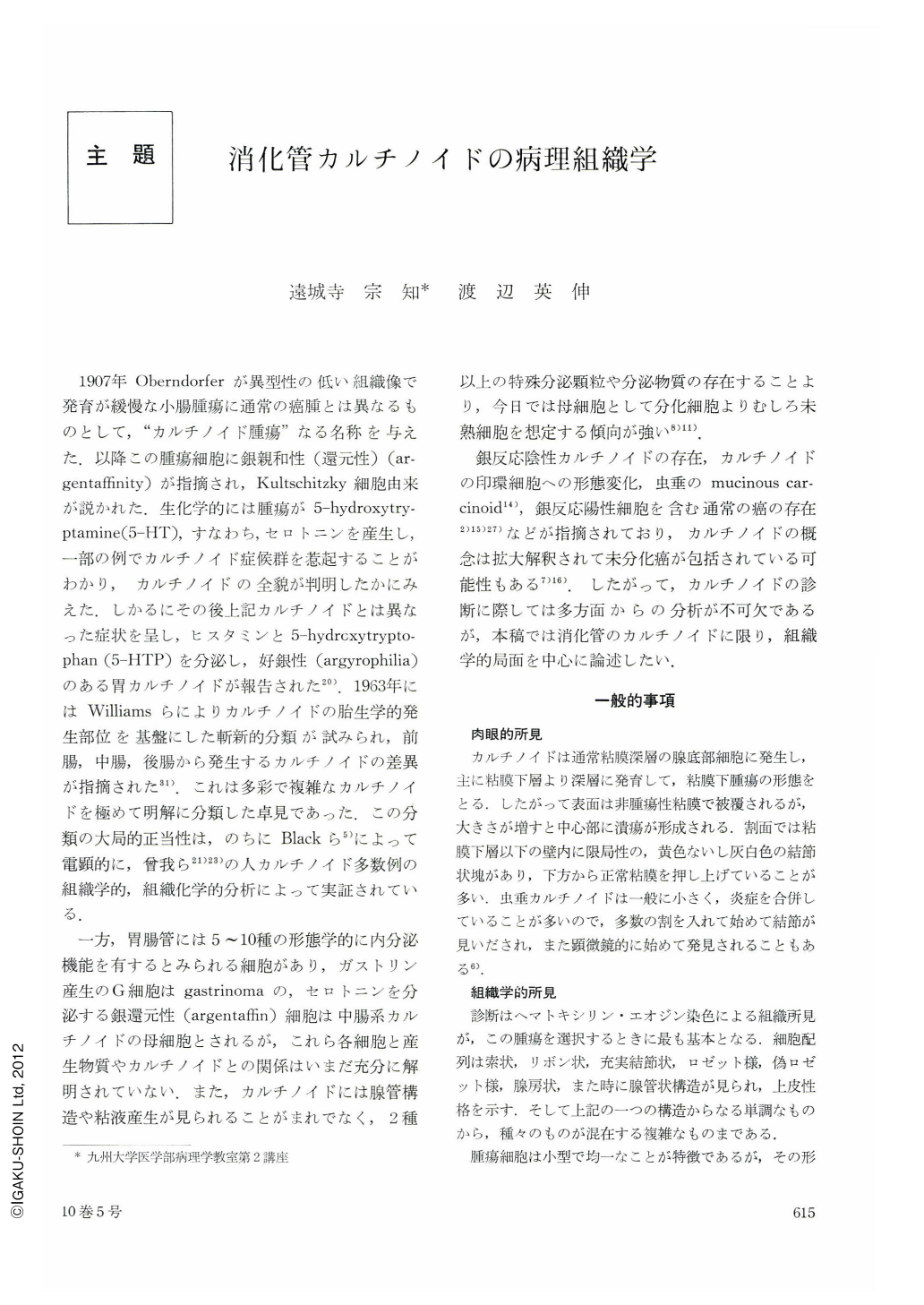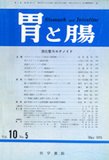Japanese
English
- 有料閲覧
- Abstract 文献概要
- 1ページ目 Look Inside
- サイト内被引用 Cited by
1907年Oberndorferが異型性の低い組織像で発育が緩慢な小腸腫瘍に通常の癌腫とは異なるものとして,“カルチノイド腫瘍”なる名称を与えた.以降この腫瘍細胞に銀親和性(還元性)(argentaffinity)が指摘され,Kultschitzky細胞由来が説かれた.生化学的には腫瘍が5-hydroxytryptamine(5-HT),すなわち,セロトニンを産生し,一部の例でカルチノイド症候群を惹起することがわかり,カルチノイドの全貌が判明したかにみえた.しかるにその後上記カルチノイドとは異なった症状を呈し,ヒスタミンと5-hydroxytryptophan(5-HTP)を分泌し,好銀性(argyrophilia)のある胃カルチノイドが報告された.1963年にはWilliamsらによりカルチノイドの胎生学的発生部位を基盤にした斬新的分類が試みられ,前腸,中腸,後腸から発生するカルチノイドの差異が指摘された.これは多彩で複雑なカルチノイドを極めて明解に分類した卓見であった.この分類の大局的正当性は,のちにBlackらによって電顕的に,曾我らの人カルチノイド多数例の組織学的,組織化学的分析によって実証されている.
一方,胃腸管には5~10種の形態学的に内分泌機能を有するとみられる細胞があり,ガストリン産生のG細胞はgastrinomaの,セロトニンを分泌する銀還元性(argentaffin)細胞は中腸系カルチノイドの母細胞とされるが,これら各細胞と産生物質やカルチノイドとの関係はいまだ充分に解明されていない.また,カルチノイドには腺管構造や粘液産生が見られることがまれでなく,2種以上の特殊分泌顆粒や分泌物質の存在することより,今日では母細胞として分化細胞よりむしろ未熟細胞を想定する傾向が強い.
Carcinoid tumors are composed of anastomosing trabeculae, ribbon-like, small solid nests or broad sheets, occasionally forming rosettes, pseudorosettes, acini or glandular structures. The tumor cells are small and often eosinophilic, and their nuclei were in general uniformly round and oval. The tumor seems to arise from the deep glandular area of the gastrointestinal mucosa and grows slowly.
According to the above-mentioned criteria, thirtyseven carcinoid tumors of the gastrointestinal tract were selected and searched for their characteristics in different portions of the tract on the histological and histochemical viewpoint. In nine gastric Carcinoids, there was an increasing tendency to complicated and variegated histological patterns with increasing size of tumors. Small carcinoids formed small solid nests or short trabeculae, the larger ones showed anastomosing trabecular and ribbon-like patterns and the largest contained some additional structures such as sheets, rosettes and glandular acini. In eight duodenal carcinoids, anastomosing trabeculae and ribbon-like structures stood out clearly from others. Four appendicular carcinoids were made up of small solid nests or short trabeculae. Sixteen rectal carcinoids showed anastomosing trabecular and ribbon-like patterns, similar to those in duodenal carcinoids, but were partially added by more various structures.
All of tho gastric and duodenal carcinoids histochemically examined were positive for the argyrophil reaction by Grimelius method. There were, however, a few argentaffin cells in two of 9 gastric carcinoids and fairly numerous argentaffin cells in one tumor of the lower duodenum. Three carcinoids of the vermiform appendix were all positive for the argentaffin reaction. On the contrary, four of 14 rectal carcinoids were positive for argyrophil, two for the argentaffin reaction and the remaining eight were non-reactive to either.
It was suggested from our results the foregut-derived carcinoids were of argyrophil cell type, the midgut-derived were of argentaffin cell type and hindgut-derived were of a variety of non-reactive, argyrophil and argentaffin cell types.

Copyright © 1975, Igaku-Shoin Ltd. All rights reserved.


